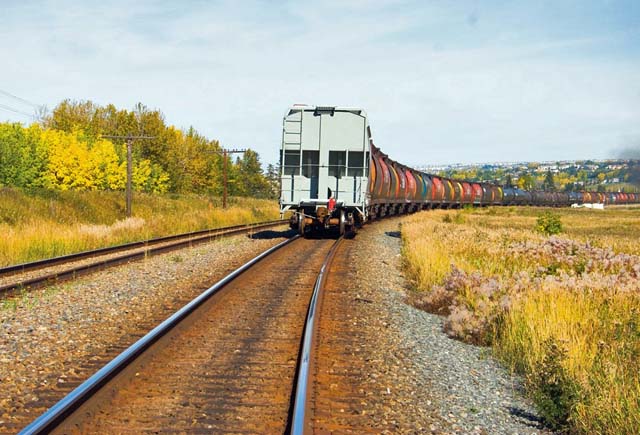
Canadian Rail Capacity?
Canada - An Alberta farmer alleges Canadian Pacific Railway (CP) isn't moving Canadian grain in a timely way because it's preoccupied shipping
American grain through Western Canada, an allegation CP denies.
The Carstairs-area farmer asked not to be identified fearing it might reveal his source.
The farmer said according to his source every day CP brings in 10 trains from the United States and moves them across Western Canada and then back to the
U.S.
And it uses Canadian government-owned hopper cars intended for western Canadian grain.
On average CP ships two trains a day of American grain across the West to the U.S. Pacific Northwest, Jeremy Berry, CP's director of media relations, said in
an email last week.
Asked if the movement affects CP's ability to handle Canadian grain Berry wrote, "Major lanes that impact Canadian grain such as Vancouver and Thunder Bay
are not impacted as U.S. grain does not travel through these ports in any significant volume."
To be efficient CP has one car fleet, which includes government cars, Berry wrote.
"We pay the government a lease rate to use the cars across our network, it is not restricted to Canada only," he wrote.
"The government cars make up only a portion of our fleet with the majority being other cars CP owns or leases.
"We also ship Canadian grain from Canada to the U.S. west coast which provides another market and alternative route and gateway for grain to move out of
Canada."
The farmer said he had a contract with Viterra to deliver canola in December to its elevator at Crossfield, but the company didn't take delivery until this
month.
The farmer said an elevator company official said it couldn't take the canola because CP wasn't delivering the cars Viterra had ordered.
When the Manitoba Co-operator emailed Viterra an official asked for more information, which was provided, but there was no response from the company by press
time.
Viterra was asked if farmers can deliver to another nearby Viterra facility when contracts are overdue.
Berry also noted that after a railway allocates cars to a grain company, the company, not the railway, decides where to spot them.
CP wanted to speak with the farmer to see if it could help resolve his issue, but the farmer declined CP's assistance.
There have been complaints about poor rail service on CP lines all crop year.
But Berry said CP is moving more grain than last year.
"Terminal unloads in Vancouver since January continue to trend upward at the port versus last year with CP up just over 12 percent since the start of
2017 at the port.
However, weekly data distributed by the Ag Transport Coalition (ATC) shows CP is, on average, 930 cars short of meeting the cars ordered for the current
week.
In week 25 the shortfall was 545 cars.
(CP disagrees with how ATC tracks car deliveries but ATC stands by its methodology.)
The problem is CP doesn't gear up to move grain in the winter when more resources are required, said Doug Robertson, president of the Western Barley Growers
Association and a farmer in the Carstairs area.
"They only make do," Robertson said in an interview 10 Feb 2017.
CP gets away with it because there is no competition, he added.
The way to fix it is allowing grain shippers to penalize the railways when they fail to provide the service they agreed to, he said.
Robertson hopes "reciprocal penalties" will be included in amendments to the Canada Transportation Act this spring.
Canada's grain-handling and transportation system is based on just-in-time delivery, Robertson said.
When a railway fails to deliver the cars companies expect, it results in over staffing at elevators and having to reschedule farmer deliveries.
At port ship loading is delayed, resulting in demurrage charges which get passed back to farmers.
The grain monitor's December report shows CP had 823 cars in storage, the Canadian National Railway (CN) a further 574.
But one industry observer said there's no point in adding cars if there aren't locomotives and crews to go with them.
The same report showed a total of 22,657 cars being used to move grain, 11,165 for CN and 11,459 for CP.
That's not far off the highest number of cars in use, 23,756, recorded in April 2014, soon after the grain monitor began tracking it in 2014.
The lowest number was 13,598 in June 2016.
Allan Dawson.
of the Canadian Copyright Modernization Act.


